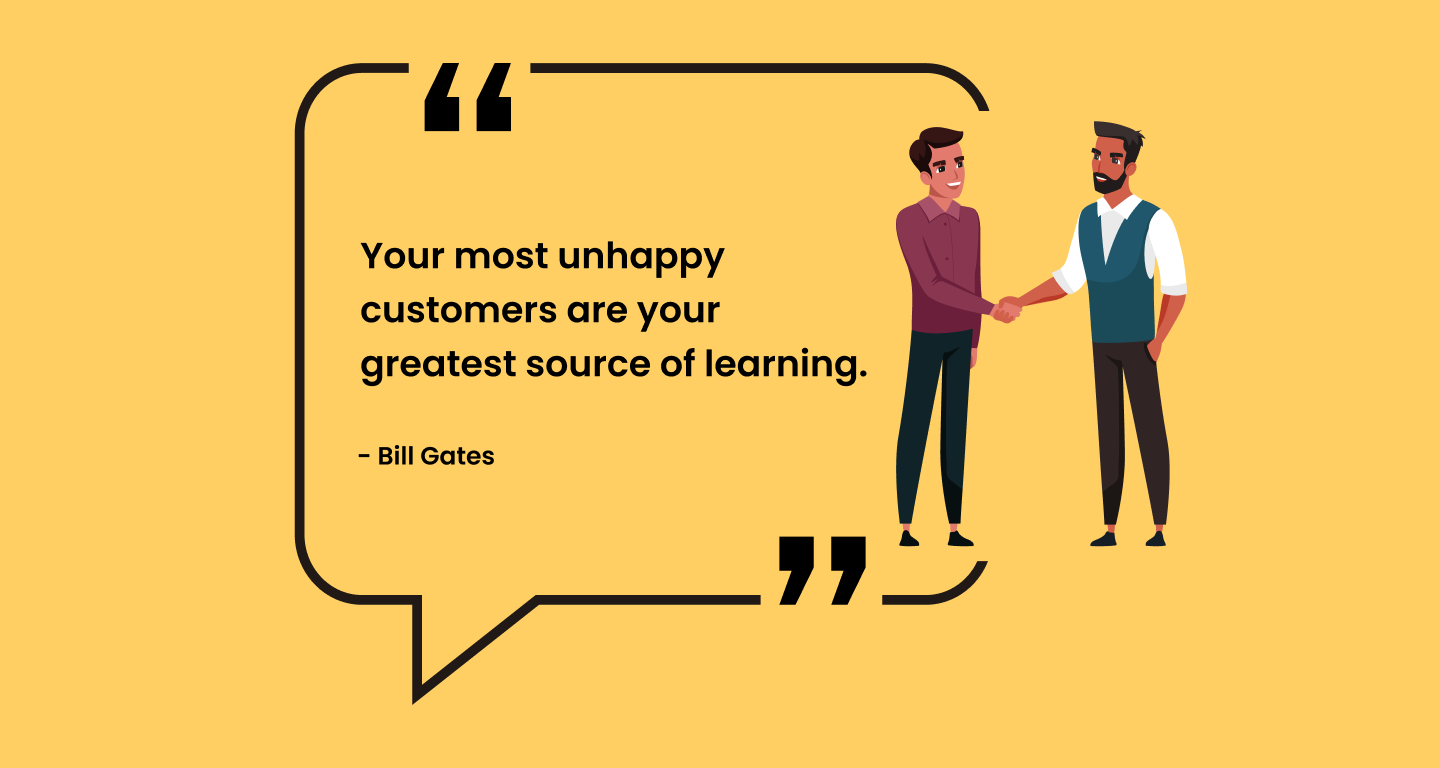Customer Experience
Bad Customer Experience: 10 Examples and Solutions to Turn It Around
Article written by Kate Williams
Content Marketer at SurveySparrow
14 min read
5 June 2025

1-Minute Summary
The blog identifies 10 common causes of bad customer experiences (CX), including:
- Ineffective communication
- Long wait times
- Untrained staff
- Lack of personalization
- Ignoring customer feedback
Each issue is paired with practical solutions, such as:
- Implementing seamless communication channels
- Automating responses to reduce wait times
- Providing comprehensive staff training
- Personalizing customer interactions
- Actively seeking and acting on customer feedback
The blog emphasizes that addressing these areas can transform negative experiences into positive ones, enhancing customer loyalty and brand reputation.
Picture this: You walk into a store with high hopes of finding just what you need, but instead, you encounter disinterested staff, long wait times, and a complete lack of assistance.
Frustrating, right? We’ve all been there—experienced a bad customer experience (CX) that leaves us feeling disappointed and even reluctant to return.
Bad customer experiences can have far-reaching consequences, impacting customer loyalty, brand reputation, and, ultimately, your bottom line. On the flip side, delivering outstanding customer experiences can lead to increased customer retention and advocacy.
So, what sets good CX apart from bad CX, and how can businesses turn negative customer experiences into positive ones?
Let’s dive in!
What is Bad Customer Experience?
Bad experiences are when customer's expectations are not met. This can lead to dissatisfaction and even frustration.
For example, you bought a book set from an online store. While the product was delivered on time, what you got was not the thing you ordered. These kinds of things happen and stores usually resolve such issues in no time.
With that in mind, you contacted their support, who said they will resolve the issue at the earliest. You returned the product you got and are waiting for the right one to come. A day went by, a week went by, and still nothing.
The support team is not picking up your calls, and the emails you sent go unnoticed. Complete ghosting.
This is what a bad customer experience would look like. If the company had replaced the product with the right one in time, it would have been a completely different story.

Understand Your Customers and Avoid Providing Bad CX!
A personalized walkthrough by our experts. No strings attached!
10 Reasons for Bad Customer Experience and How to Tackle Them
The best way to avoid providing bad CX is by understanding the reasons behind them. This is why we are listing the ten main reasons for bad customer experience and how to solve them.
1. Ineffective Communication

Miscommunication or lack of clear information can quickly lead to bad CX. Customers expect seamless interactions and timely responses.
Solution:
- Invest in seamless communication channels, offer self-service options, and ensure consistent messaging across touch points.
- Provide multiple communication channels, like chat, email, and phone, and ensure quick response times to address customer queries promptly. This helps customers feel valued and heard.
- Implement an interactive and user-friendly website with easily accessible information. Clear navigation and FAQ sections can reduce the need for customers to reach out for basic queries.
- Train customer-facing employees in effective communication skills and active listening to understand customer needs. Empathy and clear communication can make customers feel more engaged and satisfied.
2. Long Wait Times
Promptness is key. Nothing frustrates customers more than waiting endlessly for a response or assistance.
Solution:
- Implement efficient queuing systems, automate responses, and provide real-time updates on waiting times.
- Offer self-service options and chatbots to handle routine queries and reduce customer wait times. This can provide instant support and reduce customer frustration.
- Optimize staffing to handle peak hours and reduce customer queue times, ensuring timely support. Efficiently managing resources can help maintain service levels and reduce waiting times.
3. Untrained Staff
Employees who lack proper training and product knowledge can damage the customer experience.
Imagine your customer service employees being rude to the customers. The damage it can impart can take forever to recover from. This is why untrained employees can provide a bad customer experience.
Solution:
- Prioritize comprehensive training programs and empower your staff to deliver exceptional service.
- Conduct regular training sessions to keep employees updated on product offerings, industry trends, and best customer service practices. Well-informed employees instill confidence in customers.
- Encourage knowledge sharing among team members to enhance overall expertise and support one another. Collaboration can lead to a more knowledgeable and resourceful team.
4. Lack of Personalization
Customers crave personalized interactions, and failing to meet this expectation can leave them feeling like just another faceless transaction.
Solution:
- Leverage customer data to personalize interactions and recommendations. Tailor experiences to suit individual preferences.
- Implement loyalty programs and personalized offers based on customer preferences and purchase history. Recognizing and rewarding customers’ loyalty makes them feel valued.
- Use customer feedback to understand their preferences and deliver tailored experiences. Customizing recommendations and offers based on feedback enhances customer engagement.
5. Difficulty in Resolving Issues
This is something we discussed in the first section. Issues are common, but not resolving them in time can result in poor customer experience.
In other words, when customer issues are met with resistance or indifference, it only amplifies their dissatisfaction.
Solution:
- Empower frontline employees to handle complaints and ensure a swift and satisfactory resolution.
- Provide clear escalation paths for complex issues and ensure timely follow-ups with customers to reassure them that their concerns are being addressed. Transparent and empathetic communication during issue resolution can restore customer trust.
- Use customer feedback to identify recurring issues and address root causes proactively, preventing similar problems in the future. Identifying patterns can help implement permanent solutions.
6. Ignored Feedback
Dismissing customer feedback signals a lack of concern for their opinions.
Solution:
- Listen actively to customer feedback, address concerns promptly, and show appreciation for their insights.
- Establish a feedback loop to collect and analyze customer feedback, making sure to acknowledge their contributions. Demonstrating that their opinions matter encourages customers to continue sharing feedback.
- Act on constructive feedback to improve products, services, and overall customer experiences. Showing customers that their feedback drives positive changes creates a sense of ownership and partnership.
The best way to collect customer feedback is through surveys. With the right tool by your side, you can ask the right questions and reach out to a wide range of customers where they are prominent.
The following is a customer feedback survey created with SurveySparrow.
The template is available to you upon signing up along with 1000 more. Or, another option is to use AI to create surveys. Both are available with the free version of the tool, so feel free to try it out!
A personalized walkthrough by our experts. No strings attached!
7. Inconsistent Omni-channel Experience
Customers are spread out across different digital channels. So, not providing a consistent experience across all these channels can also lead to bad CX.
Solution:
- Integrate your systems and maintain consistency in customer interactions.
- Ensure a seamless transition between channels, allowing customers to switch between online and offline touch points.
- Customers should be able to continue their interactions without repeating information.
- Use customer data to provide a consistent experience, regardless of the channel they choose to interact with. Personalization and context-aware interactions enhance the omni-channel experience.
8. Lack of Empathy

Empathy is the backbone of excellent customer service. Without it, customers may feel undervalued and unimportant.
Solution:
- Train your team to empathize with customers and treat them with genuine care. Empathetic interactions foster customer loyalty.
- Encourage employees to put themselves in the customer’s shoes to better understand their perspective and emotions. Empathy demonstrates a commitment to understanding and meeting customer needs.
- Recognize and reward employees who demonstrate exceptional empathy in customer interactions, reinforcing its importance in the organization. Acknowledging empathetic efforts motivates employees to maintain a customer-centric approach.
9. Unaddressed Pain Points
Pain points are recurring issues faced by customers. So, ignoring common pain points that customers face can lead to an overall negative experience. It would give an idea that you don't care about the customers.
Solution:
- Identify pain points through surveys and reviews, then take proactive measures to address them.
- Regularly analyze customer feedback to identify recurring pain points and prioritize improvements. Actively seeking feedback and addressing pain points shows that you value customer input and are committed to continuous improvement.
- Communicate the actions taken to address pain points to customers, demonstrating your commitment to their satisfaction. Transparent communication about improvements instills confidence in customers.
10. Overpromising and Under-delivering
If your marketing messages promise a product with a quality camera, then your product should have that. Why? Because you promised something that elevated the customers's expectations. So, they will not want anything less.
Therefore, setting unrealistic expectations can lead to disappointment.
Solution:
- Be honest about what you can offer and aim to exceed customer expectations.
- Set realistic service level agreements (SLAs) and communicate them clearly to customers. Being transparent about what customers can expect manages their expectations from the outset.
- Communicate any potential delays or issues promptly and offer appropriate remedies to manage expectations effectively. Proactive communication during any challenges helps build trust and reassures customers that you are committed to their satisfaction.
By understanding the contrasting attributes, businesses can refine their CX strategies and align them with customer expectations, ultimately creating meaningful and memorable experiences that drive customer loyalty and advocacy.
6 Tips for Creating a Powerful CX Framework
If you want to take bad CX completely from the table, then we suggest following through the given tips.
Note: The base of creating a powerful CX is about understanding your customers. So before you jump into the tips, gain deep insights into your target audience, their preferences, pain points, and expectations.
How can you do that? Through targeted and customized surveys.
Use AI to create surveys tailored to your needs in seconds with SurveySparrow. The feature works similar to ChatGPT. Just add the prompt and see the magic unveil before you.

The feature is available with the free version of the tool, so feel free to try it out!
A personalized walkthrough by our experts. No strings attached!
Now, let's jump into the tips.

Tip 1 - Invest in Technology
Leverage CX tools and software to streamline processes and provide personalized experiences. Use CRM systems, live chat, and automation to enhance customer interactions.
Tip 2 - Empower Your Team
Equip your employees with the right training, resources, and authority to resolve customer issues. Encourage a customer-centric culture within your organization.
Tip 3 - Consistency Matters
Ensure a consistent experience across all touchpoints, from the first interaction to post-purchase support. Align your team’s actions with your brand promise.
Tip 4 - Proactive Customer Support
Anticipate customer needs and reach out before they encounter issues. Use AI-powered analytics to predict customer behavior and preferences.
Tip 5 - Act on Feedback
Use customer feedback to drive continuous improvements in your CX strategy. Show customers that their opinions are valued and drive changes based on their input.
Tip 6 - Celebrate Positive Interactions
Acknowledge and reward employees who go above and beyond to create memorable customer experiences. Foster a culture of recognition and appreciation.
For any strategy to work, you need the perfect tool to help you along the way. SurveySparrow might be what you’ve been looking for all this time. The conversational surveys and advanced analytics features will help you streamline the process.
Good CX vs. Bad CX
You might be wondering why there is a need to compare. Well, comparison helps us navigate through a sea of choices. When we compare, we gain valuable insights that guide us toward making smarter decisions and improving our strategies.
So, how do good and bad CX differ?
Aspect | Good CX | Bad CX |
|---|---|---|
| Communication | Prompt, clear, and friendly responses | Slow, vague, and unhelpful replies |
| Personalization | Tailored experiences based on preferences | Generic and one-size-fits-all approach |
| Issue Resolution | Swift and efficient problem-solving | Ignored or unresolved customer issues |
| Empathy | Empathetic and understanding interactions | Lack of empathy and indifference |
| Consistency | Consistent experience across all channels | Inconsistent service and information |
| Transparency | Transparent about products and policies | Hidden fees and lack of clarity |
1. Communication
- In good CX, customers receive prompt and clear responses from the brand. Customer support teams are friendly, attentive, and actively listen to customer queries.
- On the other hand, bad CX involves slow responses, vague answers, and unhelpful interactions that leave customers feeling frustrated and unheard.
2. Personalization
- Good CX provides personalized experiences based on customer preferences, purchase histories, and behaviors. This could include personalized product recommendations and tailored offers.
- In contrast, bad CX takes a one-size-fits-all approach, treating all customers as if they have the same needs and preferences.
3. Issue Resolution
- In good CX, customer issues are addressed swiftly and efficiently. The customer support team takes ownership of problems and works towards resolving them in a timely manner.
- In bad CX, customer issues may be ignored or left unresolved, leading to growing frustration and dissatisfaction. You know what might help you? SurveySparrow’s Reputation Management Platform! It lets you organize, resolve, and close the feedback loop in style!
4. Empathy
- Empathy is a key component of good CX. Brands that demonstrate empathy towards their customers make them feel valued and understood.
- On the other hand, bad CX lacks empathy, with customer interactions feeling cold and indifferent, leaving customers feeling unimportant.
5. Consistency
- Good CX ensures that customers have a consistent experience across all touchpoints and channels. Whether it’s in-store, online, or through customer support, the brand maintains a seamless and uniform experience.
- Bad CX, on the other hand, is characterized by inconsistency in service and information, leading to confusion and frustration.
6. Transparency
- Transparent communication is vital in good CX. Brands openly share information about their products, services, and policies, building trust with customers.
- In contrast, bad CX involves hidden fees, unclear terms, and a lack of transparency, which erodes customer trust and loyalty.

Understand Your Customers and Avoid Providing Bad CX!
A personalized walkthrough by our experts. No strings attached!
Consequences or Impacts of a Powerful CX Framework
Implementing a powerful CX framework can yield several significant benefits for your business.
- Increased Customer Loyalty: Providing exceptional customer experiences fosters customer loyalty, leading to repeat business and positive word-of-mouth
- Higher Customer Retention: Satisfied customers are more likely to stay with your brand, reducing churn and increasing customer lifetime value
- Enhanced Brand Reputation: Positive customer experiences contribute to a strong brand reputation, attracting new customers and retaining existing ones
- Competitive Advantage: A superior CX sets your business apart from competitors, giving you a competitive edge in the market
Investing in CX: A Wise Business Decision
Now comes the most important question to ask. Why should businesses bother investing in Customer Experience?
Just because the right strategy can fetch you the best benefits!
The benefits? Let’s take a look at them:
- Increased Revenue: Exceptional CX leads to higher customer spending and increased customer lifetime value.
- Customer Advocacy: Satisfied customers become brand advocates, driving referrals and new business.
- Competitive Differentiation: CX becomes a crucial differentiator in a competitive market, setting your brand apart.
- Employee Satisfaction: A customer-centric approach boosts employee morale and satisfaction.
Wrap Up!
Bad customer experiences can be detrimental to any business. However, by understanding the reasons behind bad CX and implementing actionable solutions, you can turn the tide and create positive customer experiences that foster loyalty and growth.
Remember, happy customers are the lifeblood of successful businesses. So, prioritize CX, listen to your customers, and deliver exceptional experiences that keep them coming back for more. And again, SurveySparrow might help you immensely. Try it for free today and see for yourself.
A personalized walkthrough by our experts. No strings attached!
Start 14 Days free trial

Kate Williams
Frequently Asked Questions (FAQs)
Poor customer experience happens when businesses fail to meet customer expectations. This further leads to frustration and dissatisfaction among them.
Some relatable examples of bad CX are unhelpful staff, receiving incorrect orders, and lack of communication regarding issues.
A bad customer service example is when a customer is transferred multiple times without resolution. This can lead to anger, frustration, and wasted time.
Related Articles

Customer Experience
15 Tips for Fostering Positive Customer Experiences
13 MINUTES
14 August 2023

Customer Experience
13 Amazing Customer Experience Examples You Should Know About
9 MINUTES
22 June 2023

Customer Experience
10 Inspiring Customer Experience Quotes to Drive Business Success
8 MINUTES
21 June 2023

Best Of
An Essential Guide to Remote Work Communications: 14 Super Actionable Tips
14 MINUTES
8 September 2020
